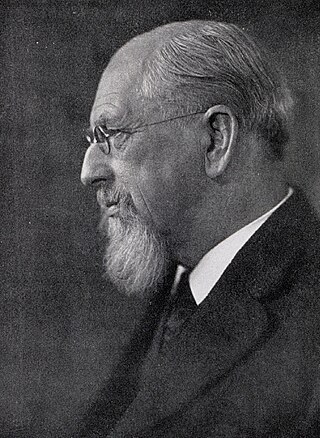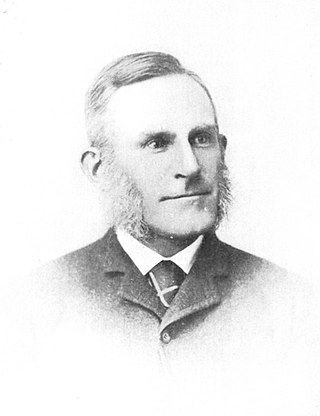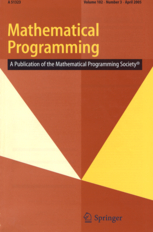
ProQuest LLC is an Ann Arbor, Michigan-based global information-content and technology company, founded in 1938 as University Microfilms by Eugene Power, a BA and MBA graduate of the University of Michigan.

Charles Doolittle Walcott was an American paleontologist, administrator of the Smithsonian Institution from 1907 to 1927, and director of the United States Geological Survey. He is famous for his discovery in 1909 of well-preserved fossils, including some of the oldest soft-part imprints, in the Burgess Shale of British Columbia, Canada.
Physical Review Letters (PRL), established in 1958, is a peer-reviewed, scientific journal that is published 52 times per year by the American Physical Society. As also confirmed by various measurement standards, which include the Journal Citation Reports impact factor and the journal h-index proposed by Google Scholar, many physicists and other scientists consider Physical Review Letters to be one of the most prestigious journals in the field of physics.

William Healey Dall was an American naturalist, a prominent malacologist, and one of the earliest scientific explorers of interior Alaska. He described many mollusks of the Pacific Northwest of America, and was for many years America's preeminent authority on living and fossil mollusks.

James Hall Jr. was an American geologist and paleontologist. He was a noted authority on stratigraphy and had an influential role in the development of paleontology in the United States.

Robert Etheridge FRS FRSE FGS was an English geologist and palaeontologist.

Samuel Hubbard Scudder was an American entomologist and paleontologist. He was a leading figure in entomology during his lifetime and the founder of insect paleontology in America. In addition to fossil insects, he was an authority on butterflies (Lepidoptera) and grasshoppers (Orthoptera).

The Smoky Hills are an upland region of hills in the central Great Plains of North America. They are located in the Midwestern United States, encompassing north-central Kansas and a small portion of south-central Nebraska.

Amadeus William Grabau was an American geologist, teacher, stratigrapher, paleontologist, and author who worked in the United States and China.

The American Geosciences Institute (AGI) is a nonprofit federation of about 50 geoscientific and professional organizations that represents geologists, geophysicists, and other earth scientists. The organization was founded in 1948. The name of the organization was changed from the American Geological Institute on October 1, 2011. The organization's offices are in Alexandria, Virginia.

William Whitaker was a British geologist.

The Professional Geographer is a quarterly peer-reviewed academic journal publishing short articles on all aspects of geography. The journal is published by Taylor and Francis on behalf of the American Association of Geographers. According to the Journal Citation Reports, the journal has a 2021 impact factor of 2.411, ranking it 46th out of 85 journals in the category "Geography".
The GeoRef database is a bibliographic database that indexes scientific literature in the geosciences, including geology. Coverage ranges from 1666 to the present for North American literature, and 1933 to the present for the rest of the world. It currently contains more than 4.3 million references. It is widely considered one of the preeminent literature databases for those studying the earth sciences.

Oliver Lanard Fassig was an American meteorologist and climatologist who worked for the United States Weather Bureau initially as part of the Signal Corps of the United States War Department and later affiliated with the United States Department of Agriculture.

Mathematical Programming is a peer-reviewed scientific journal that was established in 1971 and is published by Springer Science+Business Media. It is the official journal of the Mathematical Optimization Society and consists of two series: A and B. The "A" series contains general publications, the "B" series focuses on topical mathematical programming areas. The editor-in-chief of Series A is Jon Lee ; for Series B this is Sven Leyffer (Argonne).
Bulletin of the Seismological Society of America (BSSA) is a bimonthly peer reviewed scientific journal published by the Seismological Society of America. The editor-in-chief is Thomas Pratt. The journal covers seismology and related disciplines. Topical coverage includes theory and observation of seismic waves, specific earthquakes, the structure of the Earth, earthquake sources, hazard and risk estimation, and earthquake engineering. Publishing formats include regular papers and short notes. Publication has been continuous since 1911.

Atlantic Geology is a peer-reviewed scientific journal covering the geology of Atlantic Canada and related areas. It is the only regional geology journal in Canada and publishes papers, notes and discussions on original research, and review papers. It was established in 1965 and since 1986 has been published by the Atlantic Geoscience Society with digital publishing assistance from the University of New Brunswick. The journal was one of the first all-digital publications in Canada.

Waldeck is a ghost town in Marion County, Kansas, United States. It is currently a ghost town that was located approximately 3.5 miles north of Lehigh next to a railroad. No buildings remain of this former community.

The Bridger Formation is a geologic formation in southwestern Wyoming. It preserves fossils dating back to the Ypresian Epoch of the Paleogene Period. The formation was named by American geologist Ferdinand Vandeveer Hayden for Fort Bridger, which had itself been named for mountain man Jim Bridger. The Bridger Wilderness covers much of the Bridger Formation's area.
The South African Journal of Geology is a quarterly peer-reviewed scientific journal published by the Geological Society of South Africa that was established in March 1896 as the Transactions of the Geological Society of South Africa, obtaining its current title in 1987. Incorporated into the volumes up to and including volume 73 (1970) were the Proceedings of the Geological Society of South Africa. The journal publishes scientific papers, notes, stratigraphic descriptions, and discussions in the broadly defined fields of geoscience that are related directly or indirectly to the geology of Africa. Contributions relevant to former supercontinents such as Gondwana and Pangaea are also published as are topical studies on any geology-related discipline. The journal is abstracted and indexed in the Science Citation Index, Current Contents, GeoRef, Scopus, GEOBASE, and Academic Search.















